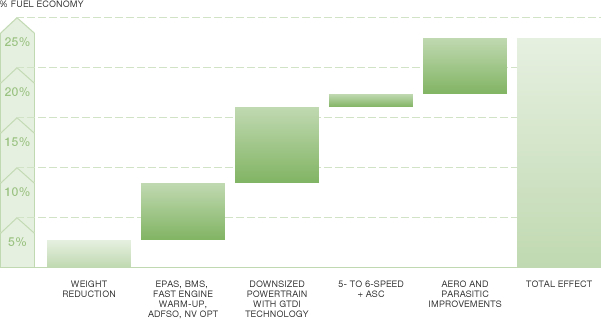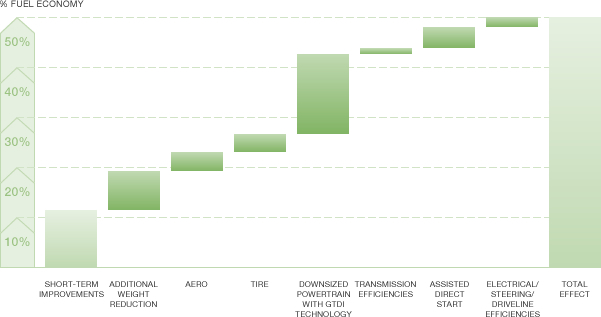Blueprint for Sustainability
In This Section
GHG Emissions Equation
Vehicle
Actions to improve the fuel economy of the vehicles we offer are the most important element of our strategy for contributing to a goal of climate stabilization. We have made progress in improving the fuel economy of our vehicles, and these improvements will accelerate as we implement our blueprint for sustainability.
In the United States, the Corporate Average Fuel Economy (CAFE) of our cars and trucks has improved. It increased 5.9 percent for the 2007 model year, compared to the 2006 model year. Preliminary data for the 2008 model year shows a 0.7 percent improvement in CAFE compared to 2007, with a 1.3 percent improvement for cars and a 4.0 percent improvement for trucks.1 As seen in this chart of Fuel Economy of U.S. Ford Vehicles by EPA Segment, our U.S. vehicles are generally competitive with others in the industry in fuel economy, ranking better than average in four of 12 categories, worse in five and the same in three.
Our 2008 North American lineup of fuel-efficient vehicles includes the 2008 Ford Escape Hybrid, Mercury Mariner Hybrid and Mazda Tribute Hybrid, which have the highest fuel economy in the SUV class, and the Ford Ranger and Mazda B2300, which are leaders in the small pickup truck class. The Ford Taurus and Mercury Sable have the highest fuel economy for an all-wheel-drive large car, according to the Environmental Protection Agency's Green Vehicle Guide. The fuel economy of the Ford Taurus is 10 percent better than its predecessor model, the Ford Five Hundred, and the 2008 North American Ford Focus gets up to 35 miles per gallon on the highway. For the 2009 model year, we will introduce hybrid versions of the Ford Fusion and Mercury Milan sedans, bringing the number of hybrid vehicles we offer in North America to five.
In Europe, we have reduced the average CO2 emissions of the vehicles we sell by 14 to 33 percent depending on the brand, compared with a 1995 base. We have achieved these reductions by introducing a variety of innovations, from the advanced common-rail diesel engines available on many of our vehicles to the use of lightweight materials.
Several advanced technologies come together in a new series of vehicles launched in Europe beginning in early 2008. The new Ford Focus ECOnetic model, for example, uses Ford's 1.6-liter Duratorq TDCi diesel engine with 109 horsepower and standard Diesel Particulate Filter to achieve class-leading CO2 emission levels of just 115 g/km. The Ford ECOnetic vehicle portfolio will be extended in 2008 to include other Ford volume sellers: first a sub-140 g/km CO2 Mondeo ECOnetic, and then a sub-100 g/km CO2 model in Ford's all-new Fiesta range.
Improvements in the fuel economy of our vehicles will accelerate as we implement our technology plan, which includes short-, medium- and long-term actions described in our Sustainable Technologies and Alternative Fuels Plan. The short-term actions have been incorporated into our cycle plan, which specifies the vehicles we will build in the next five years. We are actively researching and developing the technologies to be used in the mid to long term, including diesel hybrids and other clean diesel technologies; plug-in hybrids; biofueled vehicles; hydrogen internal-combustion engines; hydrogen fuel cell powertrains; and various combinations of these technologies, plus weight reductions.
The figures below show how we will leverage complementary technologies to cut CO2 emissions significantly.
Typical Near-Term Fuel Economy Improvements – Midsize Utility2

Typical Mid-Term Fuel Economy Improvements – Small Car2

- The percentage improvement in CAFE for cars and trucks combined is lower than the respective percentages for both cars and trucks primarily because the ratio of trucks to cars manufactured is projected to increase from 2007 to 2008. Also, the CAFE figure is calculated based on volume of vehicles manufactured as well as the fuel economy of each individual vehicle.
- For an explanation of the terms used in these figures, see the glossary.